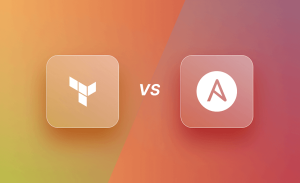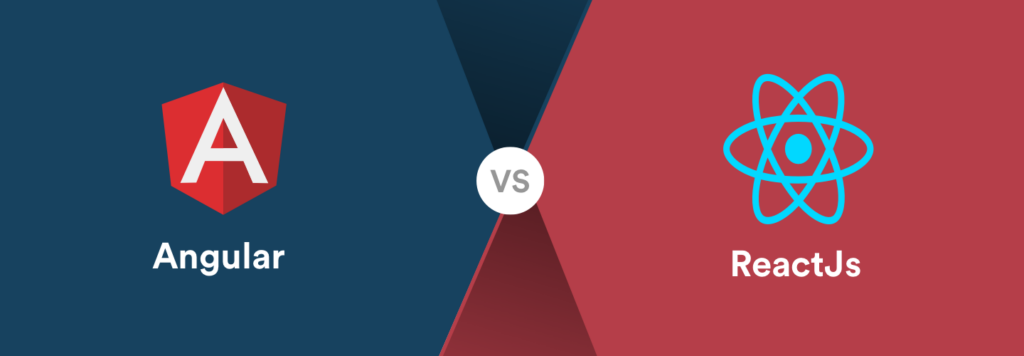
AngularJS and ReactJS are both popular JavaScript frameworks used for building web applications. Here’s a comparison between the two:
Architecture:
AngularJS: AngularJS is a full-fledged MVC (Model-View-Controller) framework. It provides a comprehensive set of features and tools for building large-scale applications.
ReactJS: ReactJS is a JavaScript library focused on the view layer of the application. It follows a component-based architecture and is often used together with other libraries or frameworks to build complete applications.
Learning Curve:
AngularJS: AngularJS has a steeper learning curve compared to ReactJS. It has a complex syntax and a large set of features, which may require more time to understand and master.
ReactJS: ReactJS has a relatively easier learning curve, especially for developers with prior knowledge of JavaScript. Its component-based approach and simple API make it easier to get started.
Performance:
AngularJS: AngularJS is known for its two-way data binding feature, which can impact performance in large applications. However, with proper optimization techniques, it can still deliver good performance.
ReactJS: ReactJS uses a virtual DOM and a one-way data flow, which can result in better performance compared to AngularJS. React’s virtual DOM efficiently updates only the necessary components, leading to faster rendering and better overall performance.
Ecosystem and Community Support:
AngularJS: AngularJS has been around for a longer time and has a mature ecosystem. It has a large community, extensive documentation, and a wide range of third-party libraries and tools available.
ReactJS: ReactJS has gained significant popularity in recent years and has a thriving ecosystem. It has a strong community support, a rich selection of open-source libraries, and a vast number of resources available online.
Flexibility and Scalability:
AngularJS: AngularJS provides a comprehensive framework with built-in features for routing, form handling, dependency injection, and more. It is suitable for building large-scale, complex applications.
ReactJS: ReactJS is more flexible and modular. It focuses on the view layer and can be easily integrated into existing projects or used alongside other libraries. It is suitable for building reusable UI components and smaller applications.
Which one is better depends on your specific requirements and preferences. AngularJS may be a better choice for enterprise-level applications with complex requirements, while ReactJS is often preferred for its simplicity, performance, and component reusability. Consider factors such as project scope, team expertise, performance needs, and ecosystem support when making a decision.
Angular and React are two popular frameworks used for web development. While Angular is a full-fledged structural framework, React is a JavaScript-based library. Here are some key points comparing the two:
- Purpose: Angular is primarily used to develop dynamic web applications, while React focuses on building interactive UI components.
- Language: Angular is written in TypeScript, a statically-typed superset of JavaScript. React, on the other hand, uses JavaScript (often with JSX script, an XML-like syntax).
- Development and maintenance: Angular is developed and maintained by Google, while React is maintained by Meta and a community of contributors.
- Front-end development approach: Angular extends the functionality of HTML and prefers client-side rendering. React uses JSX, a syntax extension for JavaScript, and has a slight preference for server-side rendering.
- DOM: Angular works with the real DOM, while React uses a virtual DOM, which renders updates faster and ensures better runtime performance.
- Dynamic UI binding: Angular supports two-way data binding, allowing for easy synchronization between the model and the view. React uses one-way data binding and focuses on direct linking of states to the UI.
- App structure: Angular has a fixed and complex platform and follows a component-based framework. React offers more flexibility and is also component-based.
- Data binding: Angular supports two-way data binding, whereas React uses one-way data binding.
- Dependency injection: Angular supports dependency injection, which allows for separate lifecycles for different stores. React does not fully enable dependency injection, as each component has its own global state.
- Learning curve: Angular can have a steeper learning curve, especially for beginners, due to its comprehensive features and concepts. React has a relatively smaller learning curve.
- GitHub stars: As of the time of writing, Angular has around 86.7k stars on GitHub, while React has approximately 203k stars, indicating their respective popularity among developers.
- Ideal use cases: Angular is often used for developing complex enterprise apps, progressive web apps, and single-page applications. React is suitable for modern, large web applications with frequently changing data, as well as for building natively-rendered hybrid apps for Android and iOS devices.
It’s important to note that the choice between Angular and React depends on various factors, including project requirements, team expertise, and personal preferences.
Popularity: Angular vs React
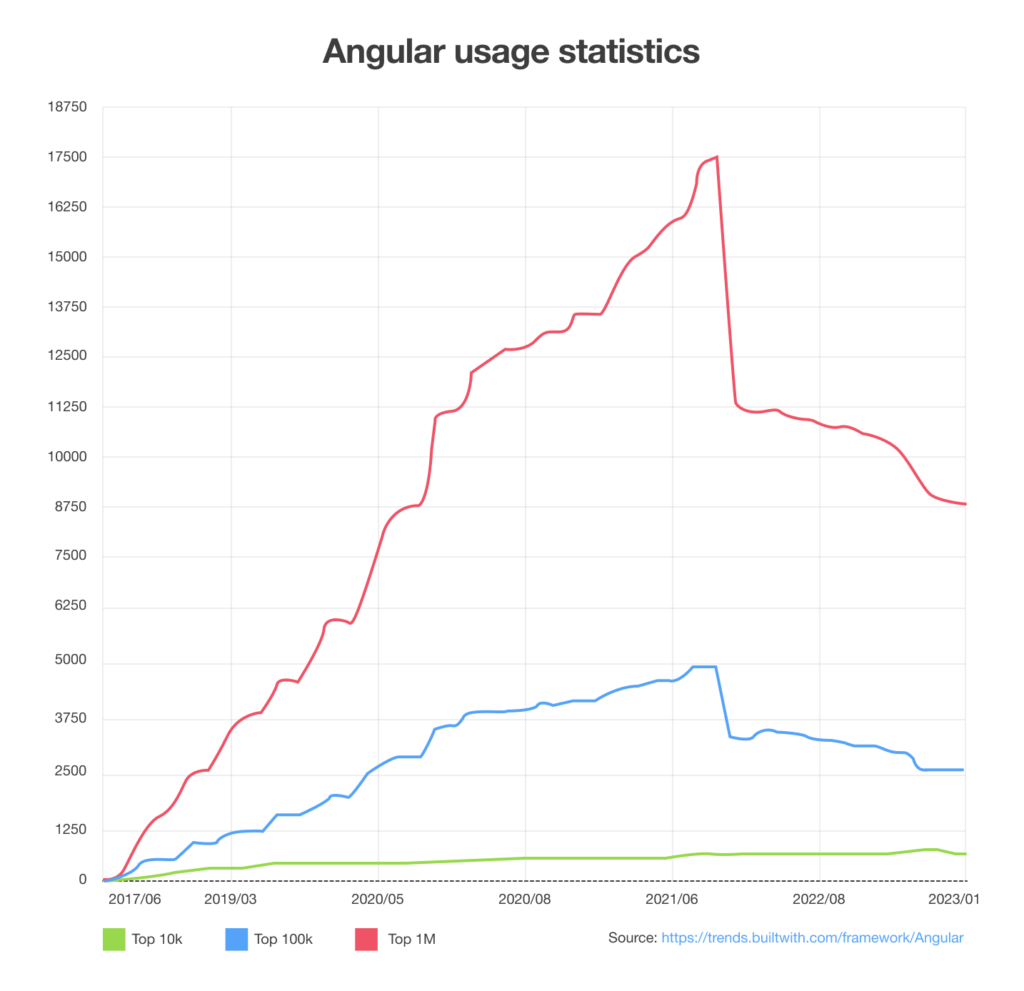
Both Angular and React are highly popular JavaScript frameworks/libraries for building web applications. However, their popularity has varied over time. Here’s a brief overview of their popularity trends:
- Angular:
- AngularJS (version 1): AngularJS gained significant popularity when it was released in 2010 and became one of the leading JavaScript frameworks for building web applications.
- Angular (version 2+): Angular (commonly referred to as “Angular 2+” or simply “Angular”) was a major rewrite of AngularJS and was released in 2016. Initially, there was some resistance to the significant changes introduced in Angular, but it gradually gained traction and popularity.
- React:
- ReactJS: React was released by Facebook in 2013 and quickly gained popularity within the developer community. Its component-based architecture and efficient virtual DOM led to widespread adoption and popularity.
- React Native: React’s popularity further skyrocketed with the release of React Native, a framework for building native mobile apps using React. It allowed developers to build cross-platform mobile apps using their existing React skills.
In recent years, React has witnessed significant growth and popularity, surpassing Angular in many developer surveys, job postings, and industry adoption. React’s simplicity, performance, and component reusability have contributed to its widespread adoption. React’s ecosystem and community support have also played a role in its popularity, with a vast number of libraries, tools, and resources available.
On the other hand, Angular remains a popular choice for enterprise-level applications and large-scale projects. Its comprehensive framework, built-in features, and extensive tooling make it suitable for complex application development. Angular has a dedicated community and continued support from Google, ensuring its relevance and adoption.
Ultimately, both Angular and React have their strengths and are widely used in the industry. The choice between them often depends on project requirements, team expertise, community support, and personal preference. It’s important to evaluate the specific needs of your project to determine which framework/library aligns best with your goals.
Performance: Angular vs React
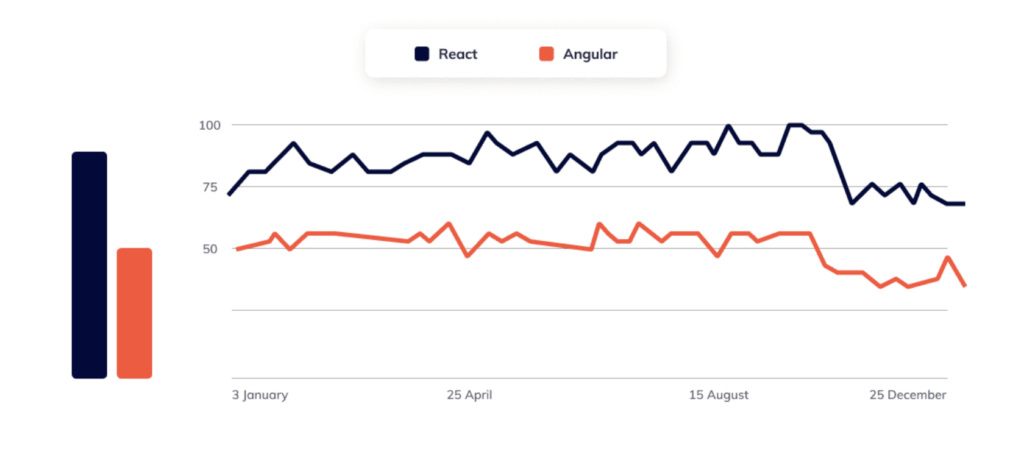
When it comes to performance, both Angular and React have their own strengths and considerations. Here’s a comparison of their performance aspects:
Angular:
- Change Detection: Angular uses a two-way data binding approach combined with its own change detection mechanism. This can sometimes result in more frequent change detection cycles, which may impact performance, especially in complex and large-scale applications.
- Bundle Size: Angular applications tend to have larger bundle sizes compared to React due to the inclusion of the Angular framework itself and its built-in features. This can affect initial load times, especially in low-bandwidth or mobile scenarios.
- Rendering: Angular relies on its own templating system and rendering engine. While it offers server-side rendering capabilities, the rendering process can be relatively slower compared to React’s virtual DOM approach.
React:
- Virtual DOM: React utilizes a virtual DOM (a lightweight in-memory representation of the actual DOM) and a diffing algorithm to efficiently update only the necessary parts of the UI. This approach minimizes direct interaction with the actual DOM, resulting in faster updates and improved performance.
- Bundle Size: React has a smaller footprint compared to Angular, making it favorable in terms of initial load times and network efficiency.
- Rendering: React’s virtual DOM and efficient diffing algorithm contribute to faster rendering and updates. Additionally, React provides server-side rendering capabilities, enabling faster initial rendering and improved SEO.
It’s worth noting that while React is often considered more performant, the actual performance of an application depends on various factors, including the specific implementation, code optimizations, and the nature of the application itself. Performance optimizations can be applied to both Angular and React applications to enhance their speed and efficiency.
Overall, React’s virtual DOM and efficient rendering mechanism have often been praised for its performance benefits. However, Angular can also achieve good performance results with proper optimization and tuning. It’s recommended to profile and benchmark your application’s performance and consider the specific requirements and trade-offs before making a decision based solely on performance considerations.
Data binding: Angular vs React

When it comes to data binding, Angular and React have different approaches.
Angular:
- Two-Way Data Binding: Angular provides built-in support for two-way data binding. This means that changes in the model (data) are automatically reflected in the view (UI), and vice versa. It simplifies the process of keeping the data and UI in sync without manually updating the view or handling event listeners.
React:
- Uni-Directional Data Flow: React follows a uni-directional data flow, also known as one-way data binding. It means that data flows in a single direction, from parent components to child components. Child components receive data through props and notify changes to parent components through callbacks. This approach promotes a more predictable and controlled data flow.
Both approaches have their advantages:
- Angular’s two-way data binding can make development faster and more intuitive by automatically synchronizing data between the model and the view. It reduces the amount of code needed for data handling and updates.
- React’s uni-directional data flow promotes a clearer data flow and helps maintain a more predictable state management. It makes it easier to reason about the application’s behavior and track the flow of data changes.
It’s important to note that React doesn’t provide built-in support for two-way data binding like Angular does. However, it’s possible to implement two-way data binding in React using additional libraries or by writing custom code.
Ultimately, the choice between Angular and React for data binding depends on personal preference, project requirements, and the development team’s familiarity with the chosen framework. Both approaches can be effective in building robust and scalable applications, so it’s essential to consider the specific needs of your project before making a decision.
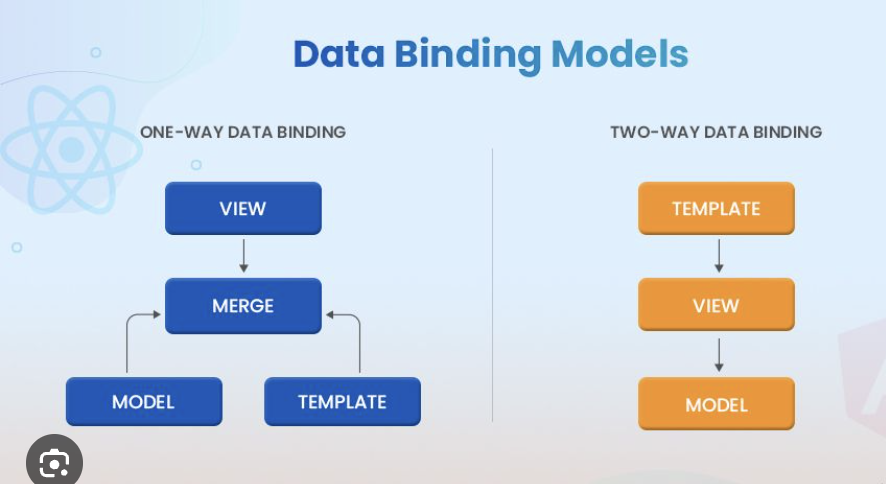
Code quality and maintainability: Angular vs React
Code quality and maintainability are important factors to consider when comparing Angular and React. Here’s an overview of how these frameworks approach code quality and maintainability:
Angular:
- Opinionated Framework: Angular is an opinionated framework that enforces a specific structure and set of best practices. It provides a clear guideline on how to structure the application, separate concerns, and write clean code. This can contribute to code quality and maintainability by promoting consistency across the project.
- TypeScript: Angular is built with TypeScript, a statically typed superset of JavaScript. TypeScript introduces static typing and provides advanced IDE support, enabling better code analysis, autocompletion, and refactoring. This can help catch errors early, improve code quality, and make codebases more maintainable.
- Comprehensive Tooling: Angular offers a comprehensive set of tools, such as Angular CLI, which provides features like code generation, scaffolding, and automated testing. These tools streamline development workflows, enforce best practices, and contribute to maintaining code quality over time.
React:
- Lightweight and Flexible: React is a lightweight library that focuses primarily on the view layer. It provides a flexible and unopinionated approach, giving developers more freedom in how they structure their code. While this flexibility can be beneficial, it also puts more responsibility on the developer to maintain code quality and structure.
- JavaScript: React is built with JavaScript and doesn’t enforce any specific typing system. While this allows developers to choose their preferred programming style, it can lead to inconsistencies and potential runtime errors. The use of additional tools like TypeScript or Flow can be adopted to add static typing to React projects and improve code quality.
- Rich Ecosystem: React has a vast ecosystem of third-party libraries and tools that can enhance code quality and maintainability. Developers can leverage tools for code linting, formatting, testing, and state management, among others, to ensure code consistency and facilitate maintenance.
Overall, both Angular and React can be used to build applications with good code quality and maintainability. Angular’s opinionated approach and TypeScript integration provide a more structured and consistent development experience, while React’s flexibility allows for customization but requires more responsibility from developers. The choice between the two frameworks should consider the development team’s preferences, project requirements, and the level of guidance and tooling desired for maintaining code quality.
Server-side rendering: Angular vs React
Server-side rendering (SSR) is an important consideration when comparing Angular and React. Here’s an overview of how these frameworks handle server-side rendering:
Angular:
- Built-in SSR Support: Angular has built-in support for server-side rendering through its Angular Universal framework. Angular Universal allows developers to render Angular applications on the server and send pre-rendered HTML to the client. This can improve initial page load times, enhance SEO, and provide a better user experience, especially for slower connections or search engine crawlers.
- Complete Solution: Angular Universal provides a complete server-side rendering solution out of the box. It handles rendering the application on the server, resolving data asynchronously, and synchronizing the initial state with the client-side application. This comprehensive approach simplifies the setup and configuration process for SSR in Angular applications.
React:
- Third-Party Libraries: React itself doesn’t provide native support for server-side rendering. However, there are several popular third-party libraries available, such as Next.js and Gatsby, that enable server-side rendering with React.
- Next.js: Next.js is a widely used framework for server-rendered React applications. It simplifies the process of setting up server-side rendering by providing a structured project setup and routing system. Next.js handles server-side rendering, code splitting, and prefetching data, making it easier to build SSR-enabled React applications.
- Gatsby: Gatsby is a static site generator that also supports server-side rendering. It pre-renders pages at build time and generates a static site that can be deployed to a server or CDN. Gatsby offers advanced optimizations, caching, and data fetching capabilities, making it suitable for content-rich websites and blogs.
When it comes to server-side rendering, Angular has native support through Angular Universal, offering a complete solution for SSR. React, on the other hand, relies on third-party libraries like Next.js and Gatsby to enable server-side rendering. These libraries provide more flexibility and customization options but require additional setup and configuration.
The choice between Angular and React for server-side rendering depends on factors such as project requirements, development team expertise, and the level of control and customization needed. Angular’s built-in support can be advantageous for developers who prefer a streamlined and integrated approach, while React’s ecosystem of third-party libraries offers more flexibility and options for SSR implementation.
Angular vs. React: When to choose which?
Choosing between Angular and React depends on various factors, including project requirements, team expertise, development goals, and the specific use case. Here are some scenarios where one framework might be more suitable than the other:
Choose Angular when:
- Large-scale applications: Angular is a comprehensive framework with built-in features and opinions on project structure, making it well-suited for complex and large-scale applications that require extensive functionality.
- Strong organization and structure: Angular enforces a specific architectural pattern (MVVM) and provides a consistent structure, making it a good choice for teams that prefer a highly organized and standardized approach.
- Enterprise-level support: Angular is backed by Google and has a strong enterprise presence, offering long-term support, extensive documentation, and a mature ecosystem.
- Full-featured framework: Angular provides a wide range of features out of the box, including routing, forms handling, dependency injection, and testing utilities, making it a suitable choice for projects that require a comprehensive solution without relying on third-party libraries.
Choose React when:
- Component-centric approach: React’s component-based architecture allows for building reusable UI components, making it ideal for projects that prioritize component reusability and modularity.
- Lightweight and flexible: React is a lightweight library that focuses primarily on the view layer. It provides flexibility in terms of choosing additional libraries, tools, and architectural patterns according to project requirements.
- Performance and virtual DOM: React’s virtual DOM and efficient diffing algorithm contribute to its performance, making it suitable for applications that require frequent updates and rendering large datasets.
- Rich ecosystem and community: React has a large and active community, with a vast ecosystem of third-party libraries, tools, and resources. This provides flexibility and extensibility options for customizing the development stack and integrating with other technologies.
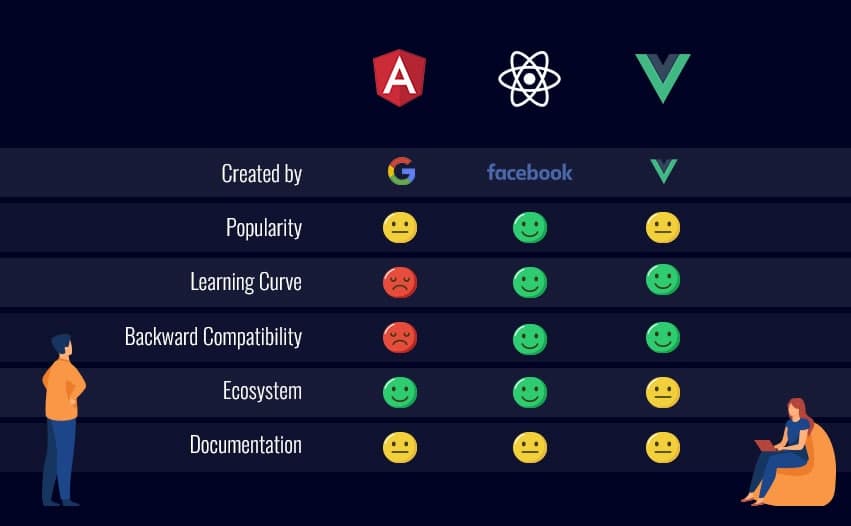
It’s worth noting that both Angular and React can be used for a wide range of projects, and the choice ultimately depends on the specific needs and preferences of the development team. It’s recommended to consider factors such as project complexity, team expertise, ecosystem support, and scalability requirements when making a decision between Angular and React.



